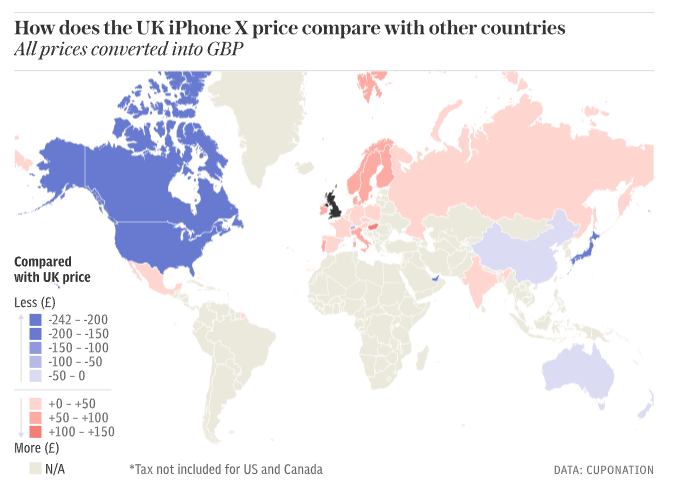 3598
3598
 2017-09-18
2017-09-18
Apple has responded to criticism of the new iPhones’ prices in the UK, saying the difference is down to foreign exchange rates, distribution costs and taxes.
The iPhone X, unveiled on Tuesday, will cost £999 in the UK, against a quoted price of $999 in the US - the first time that headline iPhone prices in pounds and dollars have been equal.
Current exchange rates mean the $999 price in the US equates to around £750, leading to suggestions that UK shoppers are paying a premium of £249 to get their hands on the phone, and that it would be even cheaper to buy a return flight to the US to buy one (although this would be illegal without paying import taxes). The cheaper iPhone 8 and 8 Plus are also priced the same in dollars and pounds.

An Apple spokesman responded on Friday by saying the UK’s 20 per cent VAT and other factors such as distribution costs also affect the price.
"Apple sets the pricing for its products in US dollars and then adjusts internationally to account for foreign exchange rates and channel distribution costs," said Apple. "In the US pricing does not include sales tax, which varies from state to state, whereas in the UK pricing includes VAT at 20 per cent."
Without VAT, the iPhone X still costs £830 in Britain, an £80 premium to the US, suggesting a further difference in extra costs or foreign exchange accounting.
"From the beginning there was a difference, and the more the price goes up the more you see the difference," said Carolina Milanesi, principal analyst at Creative Strategies. She said that as well as VAT, higher transport costs as well as the uncertainty of Brexit may have had an impact on prices.
Last year’s iPhone 7 cost $649 in the US and £599 in the UK - close, but not equal in pound and dollar terms, as the new phones are.
Back then the pound was at a roughly similar level against the dollar as it is today, so it is unclear exactly why the new iPhone has become relatively more expensive in sterling terms this year. Apple probably sets its prices several weeks or months ago, when the pound was lower against the dollar than it is now.
Source: telegraph